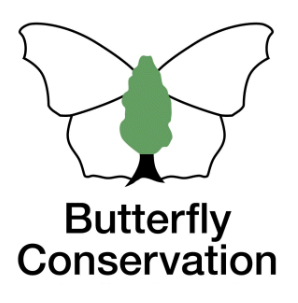Brown Argus
Brown Hairstreak
Chalkhill Blue
Clouded Yellow
Comma
Common Blue
Dark Green Fritillary
Dingy Skipper
Essex Skipper
Gatekeeper
Green Hairstreak
Green-veined White
Grizzled Skipper
Holly Blue
Large Skipper
Large White
Marbled White
Meadow Brown
Orange-tip
Painted Lady
Peacock
Purple Emperor
Purple Hairstreak
Red Admiral
Ringlet
Silver-washed Fritillary
Small Blue
Small Copper
Small Heath
Small Skipper
Small Tortoiseshell
Small White
Speckled Wood
Wall
White Admiral
White-letter Hairstreak
Extinct/rare immigrants
Brown Argus
Aricia agestis
General Distribution and Status
The Brown Argus is widespread and fairly common in the south-eastern part of Britain; from Yorkshire in the east and Dorset in the west with scattered colonies elsewhere. There was a steep decline in numbers and contraction in range in the 20th century up to the 1970s attributed to habitat destruction through farming intensification which resulted in wiping out Common Rock-rose colonies, the larval foodplants. Since the 1980s set-aside schemes across the country have benefitted the species because it was able to colonise new sites containing alternative foodplants such as Doves-foot Cranesbill (Asher et al.). There was a big expansion in the 1990s in both range and abundance undoubtedly helped by the warm and dry summers in the middle of that decade although populations have declined slightly since then. The situation in Hertfordshire and Middlesex reflects what is occurring nationwide with peak populations during 1995-97 and a small decline since until 2017 when there was a resurgence which continued more spectacularly in the warm summer of 2018 (Wood, 2019). One example of expansion was at the Bayfordbury Estate where Rob Souter notes in his review for 1994-96 that the butterfly has 're-colonised the site very quickly ... possible that the recent hot dry summers may have allowed Geranium spp. to flourish, as grasses have suffered from desiccation' (Souter). Apart from a recovery in 2023, numbers have seen abundance drop significantly in the last few years.
| United Kingdom | Herts & Middx | |||
| Distribution | 1976-2019 | +4% | 1980-2015 | +538% |
| Average 10-year trend | +1% | 2006-2015 | +35% | |
| 2024 since 2015-19 | -45% | |||
| Abundance | 1976-2024 | +24% | 1980-2015 | -69% |
| 2015-2024 | +11% | 2006-2015 | -67% | |
| 2023-2024 | -75% | 2024 since 2015-19 | -60% | |

UK distribution map
UKBMS Species summary
Habitat Requirements
The Brown Argus was associated with chalk grasslands and woodland rides but the recent expansion in range has seen it spread to other habitat types like gravel pits, roadside verges and field edges. It prefers short turf in sunny situations.
Larval Foodplants
Common Stork's-bill Erodium cicutarium, Dove's-foot Cranesbill Geranium molle.
Common Rock-rose Helianthemum nummularium on chalk.
Adult Food Sources
Common Ragwort Senecio jacobaea (6), Wild Marjoram Origanum vulgare (4), Common Fleabane Pulicaria dysenterica (4).
Historical Records
According to Gibbs' 1902 report Durrant found the butterfly at Hitchin. Foster's 1934 report describes it as 'usually abundant'. Some evidence of the decline came from Waterton's survey for 1970-1981 when he states that it has 'decreased since Foster's time in common with all the chalk-loving species due to loss of habitat and possibly climatic changes'.
Local Distribution and Abundance
As indicated on the map, the butterfly is well distributed in the Stevenage district but it appears to be absent in several areas. In the 2000s, Great Ashby Park harboured great numbers; for example, 40 on 31 July 2004 and again on 29 July 2005. However, numbers have plummeted at this site with no visit yielding more than two individuals since 2009. The best site now appears to be Frogmore Gravel Pit, where sometimes double-figure counts are recorded. More than half the records sent in for the butterfly up to 2017 reported one or two specimens only so most colonies were probably quite small. However, 2018 and 2019 were fantastic years and easily the best during the survey although no individuals were seen in the spring of 2018. In 2020, there were only ten reports and nowhere was there more than one specimen seen at a site. A very late individual in 2021 was seen south of Watery Grove on 10 October, the latest ever in the Stevenage area. Poor weather in 2024 probably impacted populations in both broods with only 8 individuals reported for the whole year - one of the worst on record since 2012. Generally, numbers have dropped significantly since 2019 perhaps partly due to the recent dry summers impacting the larval foodplant, Dove's-foot Cranesbill which was present in all the tetrads not supposedly holding Brown Argus colonies, at least in the 2000s (James), so open grassland areas with bare patches or short turf should be searched for the butterfly.

Stevenage (South Fairlands Valley Park) transect 1993-2025
Records show that the species is seen in the majority of years since 2006 which was a bumper year. It is now mostly found at Shackledell Grassland and the surrounding grassland areas. Other areas like Millennium Wood became overgrown so the Brown Argus no longer occurs there. Like the Common Blue the annual cutting regime now being carried out at Shackledell Grassland has proved beneficial to the butterfly. Singletons were found in 1996 and 1997 at the site but thereafter shrubs and coarser grasses were taking over with just the occasional cut. Whatever the reason, the Brown Argus was not seen there for at least another 9 years. 2019 was the best year with four specimens seen on 29 July at Shackledell and the grassy area west of Peartree Wood. Since 2020, only two specimens were noted, both in 2022.
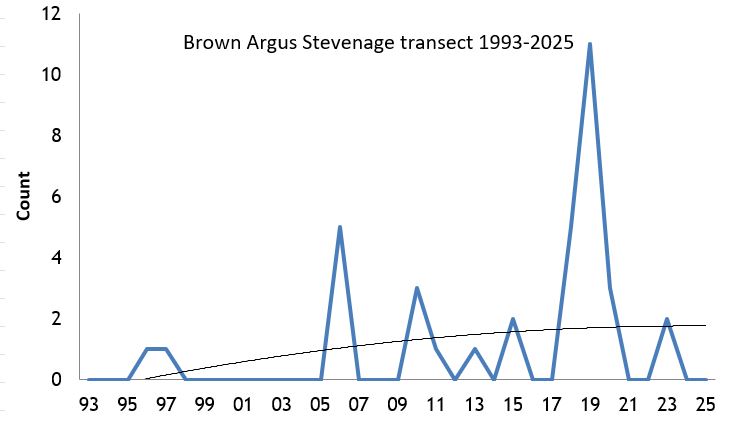
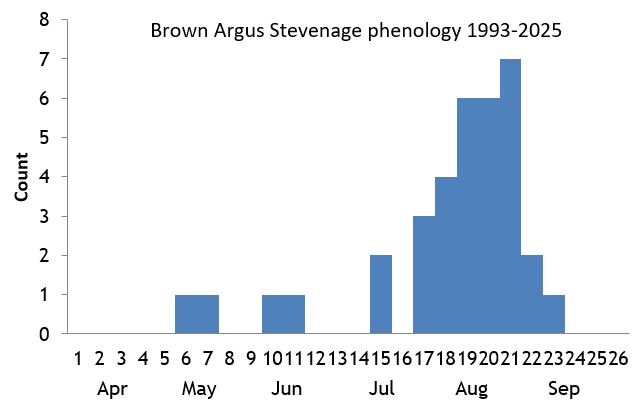
Knebworth Park transect 1996-2010 and 2017-2025
Very few were seen between 1996 and 2010 with five recorded including three in 2005. In 2017, the warm spring has undoubtedly helped produce the first reported sighting here at this time of the year. The best year was 2018 when eight were recorded including four on 21 August, all in the north-western section of Knebworth Park. However, only six individuals were seen since 2020 and none since 2023.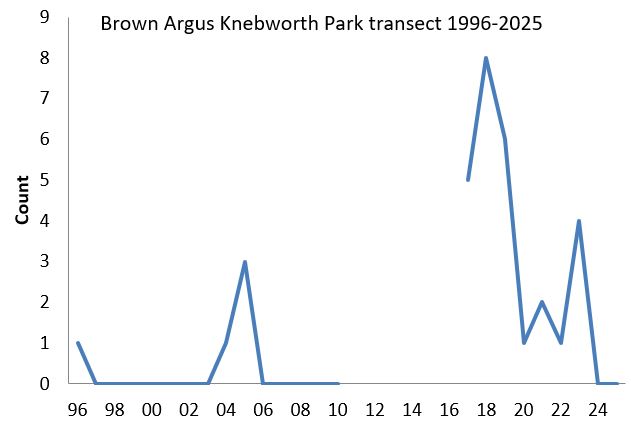

Knebworth Woods transect 2017-2025
All specimens were seen in the meadow at Norton Green Common and the top end of the open field south of the common. The highest ever local transect count was achieved here on 1 August 2018. Only two specimens were noted here since 2020 probably due to lack of suitable habitat, which is a concern.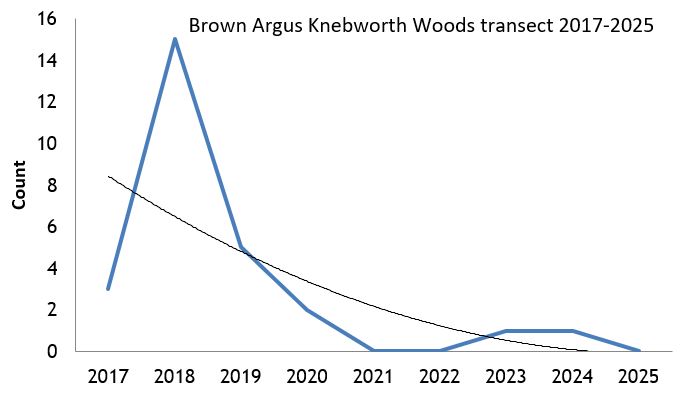

Pryor's Wood transect 2000-2022
Only one record of this species - on 10 August 2003.Life History
Earliest date: 20 April 2007 at Frogmore Gravel Pit
Latest date: 10 October 2021 at Watery Grove
The Brown Argus is a bi-voltine species with the second generation nearly always found in greater numbers. Eggs are laid singly on the underside of a leaf of
the foodplant. Larvae eat the underside of the leaves resulting in visible patches seen from above and are often attended to by ants. Pupae are formed on the
base of the foodplant but sometimes they are buried in ant hills. It overwinters in the larval stage.
Behaviour/Observation notes
This species usually flies close to the ground and enjoys basking on sunny bare patches or on grass stems. As noted in the account for the Common Blue this species can be confused with the female Common Blue if the latter has minimal blue scales on its wings. The undersides of the Brown Argus differ in the spotting pattern in two ways: 1) the white-ringed black spot on the forewings near the body is absent and 2) the pair of spots nearest the inner edge of the hindwings is closer together which constitutes almost like a figure '8'. Good photographic opportunities can be obtained early in the morning when a number of individuals roost on tall grasses along with Common Blues (Riley).
Variations/Aberrations
There is some natural variation in the extent of the orange spots on the wings. A number of aberrations have been
reported around the country and the one which is most encountered in Hertfordshire appears to be ab. snelleni where the black discal spots
on the forewings are ringed with white - see photo on the right for specimen seen near Watery Grove on 2 August 2019.
Find out more on the UK Butterflies website
References
Asher, J., Warren, M., Fox, R., Harding, P., Jeffcoate, G. and Jeffcoate, S. (2001). The Millennium Atlas of Butterflies in Britain and Ireland, Oxford University Press, Oxford

Bareleigh 26 July 2016 (m)

Knebworth Park 22 May 2019 (f)

Pair Shackledell 4 Sep 2017

ab. snelleni Watery Grove 2 Aug 2019
